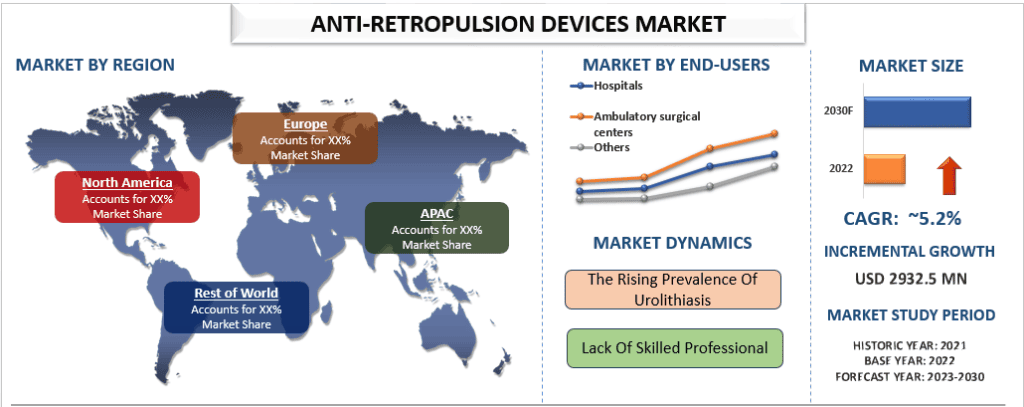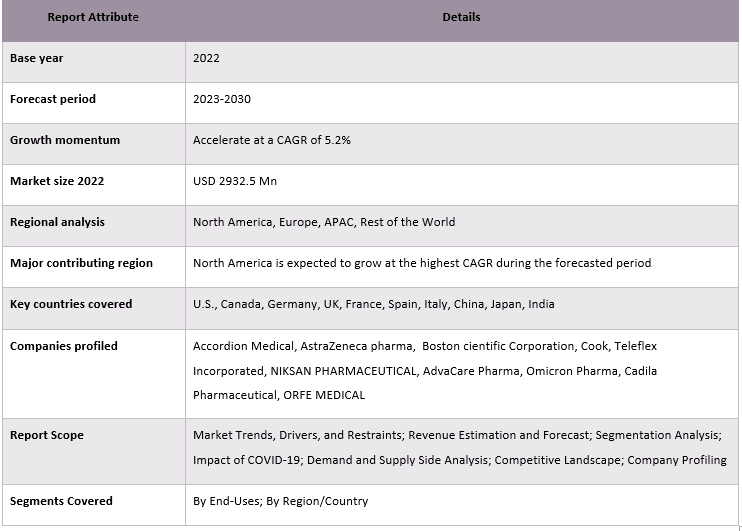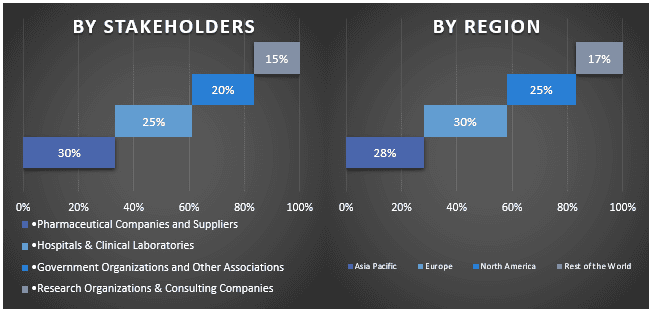- Home
- About Us
- Industry
- Services
- Reading
- Contact Us
Anti-retropulsion Devices Market: Current Analysis and Forecast (2023-2030)
Emphasis on End-Users (Hospitals, Ambulatory surgical centers, Others); and Region/Country

The Anti-retropulsion devices market was valued at USD 2932.5 Mn in 2022 & is expected to grow at a CAGR of 5.2% from 2023-2030. The antiretropulsion device market refers to the segment of the medical device industry focused on devices designed to prevent stone migration during endoscopic procedures, particularly in the field of urology. These devices are utilized during procedures such as ureteroscopy to enhance the efficacy and safety of stone removal by minimizing the risk of stone migration back into the kidney or other parts of the urinary tract. The rising incidence and prevalence of urolithiasis (urinary tract stones) globally have heightened the demand for effective and minimally invasive treatment options, thereby driving the adoption of antiretropulsion devices in endourological procedures. For instance, according to the NCBI, In 2019, 11,55,52,140 incident cases of urolithiasis with 6,04,308.9 attributed DALYs and 13,278.9 deaths occurred globally. Furthermore, Continuous innovation and advancements in antiretropulsion device technology, including the development of devices with enhanced maneuverability, flexibility, and compatibility with endoscopic equipment, are driving market growth.
Some of the major players operating in the market include Accordion Medical, AstraZeneca pharma, Boston cientific Corporation, Cook, Teleflex Incorporated, NIKSAN PHARMACEUTICAL, AdvaCare Pharma, Omicron Pharma, Cadila Pharmaceutical, ORFE MEDICAL. Several M&As along with partnerships have been undertaken by these players to facilitate customers with hi-tech and innovative products/technologies.
Insights Presented in the Report
“Amongst end-users, the hospital segment held a significant share of the market in 2023.”
Based on the end-user, the market has been categorized into hospitals, ambulatory surgical centers, others. Among them, the hospital category is to witness higher adoption of anti-retropulsion devices during the forecast period. The hospitals are witnessing a surge in admissions for urological disorders, including urinary tract stones, necessitating the utilization of antiretropulsion devices in endourological procedures to optimize patient outcomes. Moreover, hospitals are equipped with advanced infrastructure, state-of-the-art endoscopic equipment, and specialized facilities that facilitate the effective utilization of antiretropulsion devices in minimally invasive urological procedures. Furthermore, hospitals often have specialized urology departments and skilled healthcare professionals proficient in endourological interventions, thereby fostering the adoption and integration of antiretropulsion devices in urological care pathways.
“North America dominated the anti-retropulsion devices market in 2023.”
The North America Anti-retropulsion Devices market is expected to continue to grow in the coming years, driven by the increasing prevalence of urolithiasis and growing awareness of anti-retropulsion devices among healthcare professionals and the general population, development of training and education and the rise in healthcare expenditure. For instance, in 2020, according to census.gov, The older population increased by 50.9 million, from 4.9 million (or 4.7% of the total U.S. population) in 1920 to 55.8 million (16.8%) in 2020.
Anti-retropulsion devices Market Report Coverage

Reasons to buy this report:
- The study includes market sizing and forecasting analysis validated by authenticated key industry experts.
- The report presents a quick review of overall industry performance at one glance.
- The report covers an in-depth analysis of prominent industry peers with a primary focus on key business financials, product portfolios, expansion strategies, and recent developments.
- Detailed examination of drivers, restraints, key trends, and opportunities prevailing in the industry.
- The study comprehensively covers the market across different segments.
- Deep dive regional level analysis of the industry.
Customization Options:
The global Anti-retropulsion devices market can further be customized as per the requirement or any other market segment. Besides this, UMI understands that you may have your own business needs, hence feel free to connect with us to get a report that completely suits your requirements.
Table of Content
Research Methodology for the Anti-retropulsion devices Market Analysis (2022-2030)
Analyzing the historical market, estimating the current market, and forecasting the future market of the global Anti-retropulsion devices market were the three major steps undertaken to create and analyze the adoption of anti-retropulsion devices in major regions globally. Exhaustive secondary research was conducted to collect the historical market numbers and estimate the current market size. Secondly, to validate these insights, numerous findings and assumptions were taken into consideration. Moreover, exhaustive primary interviews were also conducted, with industry experts across the value chain of the global Anti-retropulsion devices market. Post assumption and validation of market numbers through primary interviews, we employed a top-down/bottom-up approach to forecasting the complete market size. Thereafter, market breakdown and data triangulation methods were adopted to estimate and analyze the market size of segments and sub-segments of the industry pertains to. Detailed methodology is explained below:
Analysis of Historical Market Size
Step 1: In-Depth Study of Secondary Sources:
Detail secondary study was conducted to obtain the historical market size of the Anti-retropulsion devices market through company internal sources such as annual reports & financial statements, performance presentations, press releases, etc., and external sources including journals, news & articles, government publications, competitor publications, sector reports, third-party database, and other credible publications.
Step 2: Market Segmentation:
After obtaining the historical market size of the Anti-retropulsion devices market, we conducted a detailed secondary analysis to gather historical market insights and share for different segments & sub-segments for major regions. Major segments are included in the report as end-users. Further country-level analyses were conducted to evaluate the overall adoption of testing models in that region.
Step 3: Factor Analysis:
After acquiring the historical market size of different segments and sub-segments, we conducted a detailed factor analysis to estimate the current market size of the Anti-retropulsion devices market. Further, we conducted factor analysis using dependent and independent variables such as end-users of the Anti-retropulsion devices market. A thorough analysis was conducted for demand and supply-side scenarios considering top partnerships, mergers and acquisitions, business expansion, and product launches in the Anti-retropulsion devices market sector across the globe.
Current Market Size Estimate & Forecast
Current Market Sizing: Based on actionable insights from the above 3 steps, we arrived at the current market size, key players in the global Anti-retropulsion devices market, and market shares of the segments. All the required percentage shares split, and market breakdowns were determined using the above-mentioned secondary approach and were verified through primary interviews.
Estimation & Forecasting: For market estimation and forecast, weights were assigned to different factors including drivers & trends, restraints, and opportunities available for the stakeholders. After analyzing these factors, relevant forecasting techniques i.e., the top-down/bottom-up approach were applied to arrive at the market forecast for 2030 for different segments and sub-segments across the major markets globally. The research methodology adopted to estimate the market size encompasses:
- The industry’s market size, in terms of revenue (USD) and the adoption rate of the Anti-retropulsion devices market across the major markets domestically
- All percentage shares, splits, and breakdowns of market segments and sub-segments
- Key players in the global Anti-retropulsion devices market in terms of products offered. Also, the growth strategies adopted by these players to compete in the fast-growing market
Market Size and Share Validation
Primary Research: In-depth interviews were conducted with the Key Opinion Leaders (KOLs) including Top Level Executives (CXO/VPs, Sales Head, Marketing Head, Operational Head, Regional Head, Country Head, etc.) across major regions. Primary research findings were then summarized, and statistical analysis was performed to prove the stated hypothesis. Inputs from primary research were consolidated with secondary findings, hence turning information into actionable insights.
Split of Primary Participants in Different Regions

Market Engineering
The data triangulation technique was employed to complete the overall market estimation and to arrive at precise statistical numbers for each segment and sub-segment of the global Anti-retropulsion devices market. data was split into several segments & sub-segments post studying various parameters and trends in the areas of the end-users in the global Anti-retropulsion devices market.
The main objective of the Global Anti-retropulsion devices Market Study
The current & future market trends of the global Anti-retropulsion devices market were pinpointed in the study. Investors can gain strategic insights to base their discretion for investments on the qualitative and quantitative analysis performed in the study. Current and future market trends determined the overall attractiveness of the market at a regional level, providing a platform for the industrial participant to exploit the untapped market to benefit from a first-mover advantage. Other quantitative goals of the studies include:
- Analyze the current and forecast market size of the Anti-retropulsion devices market in terms of value (USD). Also, analyze the current and forecast market size of different segments and sub-segments
- Segments in the study include areas of the end-users
- Define and analysis of the regulatory framework for the Anti-retropulsion devices industry
- Analyze the value chain involved with the presence of various intermediaries, along with analyzing customer and competitor behaviors of the industry
- Analyze the current and forecast market size of the Anti-retropulsion devices market for the major region
- Major countries of regions studied in the report include Asia Pacific, Europe, North America, and the Rest of the World
- Company profiles of the Anti-retropulsion devices market and the growth strategies adopted by the market players to sustain in the fast-growing market
- Deep dive regional level analysis of the industry
Frequently Asked Questions FAQs
Q1: What is the current market size and growth potential of the global anti-retropulsion devices market?
Q2: What are the driving factors for the growth of the global anti-retropulsion devices market?
Q3: Which segment has the largest share of the global anti-retropulsion devices market by end user?
Q4: What are the emerging technologies and trends in the global anti-retropulsion devices market?
Q5: Which region will dominate the global anti-retropulsion devices market?
Q6: Who are the key players operating in the global anti-retropulsion devices market?
Related Reports
Customers who bought this item also bought










